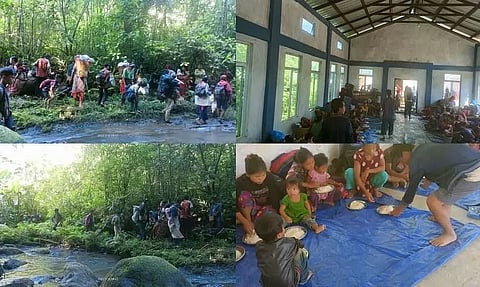
- Home
- Live Blog
- Breaking News
- Top Headlines
- Cities
- NE News
- Sentinel Media
- Sports
- Education
- Jobs

AIZAWL: Sexagenarian Bawilianthang of Bangladesh accompanied by his wife and children trekked more than 50 km in around three days through the dense forest and mountains to reach Mizoram. They slept in the jungle and starved before taking shelter at Bonduk-Bangsora, a bordering village in Mizoram near the tri-junction of India, Bangladesh and Myanmar on November 20.
Along with his wife and two children, the tribal elderly man left his home and properties in the mountainous Chittagong Hills Tracts (CHT) in southeast Bangladesh and fled to Mizoram in Northeast India.
Bawilianthang and his family are among the 272 tribals, including women and children, belonging to the Bawm tribes of the Chin-Kuki-Mizo group, who run away from their ancestral homes in the CHT in the wake of armed conflict between the Bangladesh Army and the Kuki-Chin National Army (KNA), also known as Kuki-Chin National Front (KNF).
The KNA is an underground militant outfit, demanding sovereignty for the minority Chin-Kuki tribals residing in the Rangamati and Bandarban districts of CHT and to protect the tribals' tradition, culture and livelihood.
The Bangladeshi tribal nationals were now lodged at a community hall, a school and a sub-centre in Parva-3 village, in southern Mizoram's Lawngtlai district.
Narrating their ordeals, Bawilianthang said that they from the seven villages met in the jungle after the violent conflict broke out between the Bangladesh Army's Rapid Action Battalion (RAB) and the KNA and then fled to India.
"Except for water from the hilly streams, we had nothing to eat for three to four days. We slept two nights in the forest. Ailing men and women, children, and elderly people suffered a lot after they fled from their homes and villages. However, we luckily did not suffer from snakebite or being attacked by wild animals," he said.
He added that they did not even get time to carry foodstuffs or valuables amidst the offensive against the KNA by the RAB, which reportedly also took the assistance of Myanmar's main insurgent group Arakan Army.
Bawilianthang said that after the armed conflict with the KNA started a month ago, the "Bangladesh Army in association with the Arakan Army raided many villages, and assaulted and arrested many tribals while some were forcibly sent to jail without any fault and prevented them from going from one village to another".
"The soldiers threatened to kill us. Many of our people are missing. We were unsafe in our villages. The Muslim people boycotting us socially. We used to sell our agricultural and horticultural products in the markets but the Muslims refused to buy anything from us," he said.
Lawngtlai district Deputy Commissioner Amol Srivastava told IANS that he is apprehending that more Chin-Kuki tribals will be fleeing to Mizoram to escape from the troubles in CHT.
The Deputy Commissioner in a letter has asked the Sub-Divisional Officer (Civil) of Change that as more tribals from Bangladesh are expected to come, it is felt necessary to make arrangements to relocate some asylum seekers to Chamdur Project, Mautlang and Hmawngbu villages.
"You are thus required to coordinate with the Village Councils of the respective villages and the Mizoram Bawm Students' Association for necessary arrangements. Action taken report on the subject may be submitted at the earliest," read the DC's letter to SDO.
The Chin-Kuki tribals and the Mizos in Mizoram belong to the Zo community and share the same culture and ancestry besides they all are Christians.
The Bangladeshi tribals took shelter in India 36 years after the 74,000 Buddhist Chakma tribals took shelter in southern Tripura in 1986.
However, the Chakma refugees returned to their villages in CHT in 1997-1998 after the Bangladesh government signed the CHT peace accord with 'Shanti Bahini' on December 2, 1997.
The 'Shanti Bahini', which was the underground outfit of the 'Parbatya Chattagram Jana Samhati Samiti', formed in 1972, soon after Bangladesh became independent with India's military assistance, had been fighting for the autonomy of the tribals.
The peace accord allowed for the recognition of the rights of the tribals in the CHT region, among other issues.
Mizoram's influential NGO Young Mizo Association's (YMA) Tuichawng unit Vice-President Richies Laltanpuia, who is dealing with the Bangladeshi refugees, said that many children among those who sheltered Mizoram came without their parents, some women came without their husbands and children and also some men came without their wives and kids.
"More people are expected to come to Mizoram in Bangladesh," the YMA leader said.
The YMA collected clothing, food and other reliefs for the Kuki-Chin refugees, he said.
Like the Myanmar refugees, the Mizoram government is providing similar food, relief, and shelter to the 272 Bangladeshi tribals. (IANS)
Also Watch: